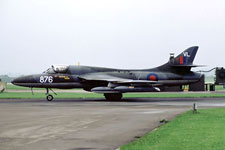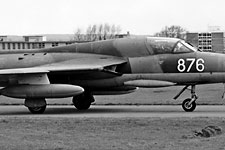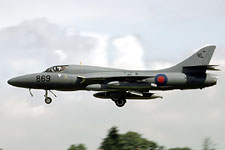| XF310's service history
Hawker Hunter XF310 was built by Hawker Aircraft (Blackpool) Ltd. as a Mk.4 for the Royal Air Force, but it never entered service as such. Instead the aeroplane was delivered to Fairey Aviation Ltd in June 1956, and became the main test-bed for testing the company's air-to-air missile, the Fireflash. Special pylons were fitted beneath the wings, and booster rockets above and below the body of the missile. Despite receiving some interest throughout the project, there was little commitment and the RAF eventually made the decision to order the alternative de-Havilland built Firestreak weapon instead.
In 1958, XF310 was declared surplus to requirements and was moved back to Hawkers for refurbishment and became one of six Hunter F.4s to be converted to T.7 specification.
Now in two-seat guise, XF310 was test flown for the first time on 24th April 1959 by Frank Bullen, and finally joined the RAF on 29th May the same year.
The aeroplane was first issued to RAF 20(F) Sqn based at RAF Tengah, Singapore as aeroplane 'T' and it remained in use with the Unit until March 1967, when it was returned to the UK for storage and maintenance at RAF Kemble with 5MU (Maintenance Unit). It was placed on loan to the Fleet Air Arm in July 1969, and began a spell with RNAS Yeovilton's Heron Flight as aeroplane '738', suffering damage caused by a wheels-up landing on a foam carpet in March 1970. The aeroplane was subsequently repaired and was returned to the Royal Air Force in May 1971. XF310 then saw service with the newly-reformed RAF 45 Sqn based at RAF West Raynham, and moved with the Unit to RAF Wittering, a location where XF310 was later moved onto the strength of RAF 58 Sqn as aeroplane 'T'.
Following the withdrawal of the Hunter type from the Squadron in 1976, XF310 was moved to RAF Kemble for storage and maintenance.
XF310 was officially transferred to the Fleet Air Arm on 1st October 1976, but it remained in store at Kemble until it was placed on loan back to the Royal Air Force on 20th June 1977. The aeroplane then became a part of 2TWU based at RAF Lossiemouth, and also served at RAF Laarbruch, West Germany as part of the Station Flight as '01'.
Returned to the Fleet Air Arm, XF310 joined the Fleet Requirements and Air Direction Unit (FRADU) at RNAS Yeovilton on 4th August 1981, still wearing its RAF camouflage colour scheme. It was operated as such, with the addition of its fleet number '876' under the cockpit, until it was ferried to RAF Abingdon for modernisation on 16th November 1983. The aeroplane returned to the FRADU fleet on 1st April 1985, painted in the revised dark sea grey standard finish and as aeroplane '869'. Aside from spells of maintenance at Lovaux Ltd at Hurn (May-August 1989, March-December 1991) and a short loan spell with the RAF during January 1992, XF310 remained active with FRADU until its last military flight to RNAS Culdrose on 25th March 1993.
Relegated to ground instructional use, it adopted the maintenance serial 'A2618' and was maintained in serviceable condition by the SFDO (School of Flight Deck Operations) until January 1997 when it was offered for disposal. |

[© Rob Schleiffert]

[© Peter R. March]

[© Rob Schleiffert]
|
XF310's civilian life
Sold at auction, XF310 moved into private ownership with a syndicate based in Tasmania, Australia. It was dismantled and shipped out to its new home but unfortunately suffered serious salt water damage in transit, rendering the engine useless. On arrival, the aeroplane was placed in store and was later sold to new owners based in Melbourne.
The airframe is now on display within Australia at The Emily Museum in Cheltenham, Victoria.
- December 2020
Links
- The Emily Museum:

|

[© Lindsay Millar]
|
